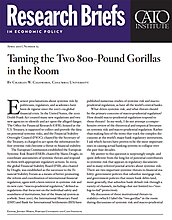The European Commission established the European Systemic Risk Board (ESRB), chaired by Mario Draghi, to coordinate assessments of systemic threats and respond to them with appropriate regulatory actions. In 2009, the global Financial Stability Board (FSB), also chaired by Draghi, was established as the successor to the Financial Stability Forum as a means of better promoting the reform and coordination of international financial regulation, again with a keen interest in systemic risk and its new cure: “macro-prudential regulation,” defined as regulations that focus not on the individual safety and soundness of institutions, but of the financial system as a whole. Since 2007, the International Monetary Fund (IMF) and Bank for International Settlements (BIS) have published numerous studies of systemic risk and macroprudential regulation, as have all the world’s central banks.
What drives systemic risk, and what threats should be the primary concerns of macro-prudential regulation? How should macro-prudential regulation respond to those threats? In my work, I do not attempt a comprehensive review of the theoretical and empirical literature on systemic risk and macro-prudential regulation. Rather than making lists of the items that track the complex discussions at the world’s major bank regulatory institutions, I ask which factors have proven to be the most important ones in causing actual banking systems to collapse over the past four decades.
My answer to this question is surprisingly simple, and quite different from the long list of potential contributors to systemic risk that appears in regulatory documents and in many refereed journal articles about systemic risk. There are two important systemic threats to financial stability: government policies that subsidize mortgage risk, and government policies that insure bank debts (and, more generally, that subsidize bank default risk through a variety of channels, including—but not limited to—“toobig-to-fail” protection).
My discussion of these institutional threats to stability—which I label the “two gorillas” in the room during discussions of systemic risk and macro-prudential 2 regulation—is divided into four parts. First, I briefly review the evidence that these are the most important threats to systemic stability. As part of that discussion, I show that the two 800-pound gorillas are not really independent problems, but part of the same political equilibrium. The worldwide boom in the insurance of bank debt should be understood, in part, as a means for government to create off-budget rents within financial intermediaries that can be used, not only to prop up bank profits, but also to fund subsidies to certain classes of borrowers.
Second, I discuss the most obvious economic solutions to these problems (“just say no”), and discuss the less effective partial solution to the problem that our policymaking apparatus has identified (higher and timevarying capital requirements, etc.). These policies could be useful if they were credible, but regulatory policy is made within the same political system that created the two gorillas; politics defines the incentives of policymakers, which makes it unlikely that the current prudential regulatory apparatus will produce systemic stability.
Third, I consider the incentive problems within economic research that have added to the problems posed by the two gorillas by underplaying their importance, and overplaying other more complicated, but less important, influences on systemic risk. Finally, I consider new approaches to regulatory design that try to reduce systemic risk while taking political constraints into account.
NOTE:
This research brief is based on Charles W. Calomiris, “Taming the Two 800 Pound Gorillas in the Room,” February 1, 2017 https://papers.ssrn.com/sol3/papers.cfm?abstract_id=2909846.

